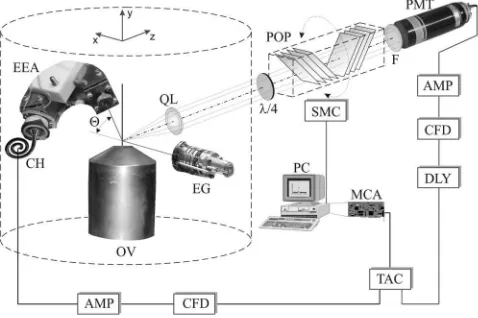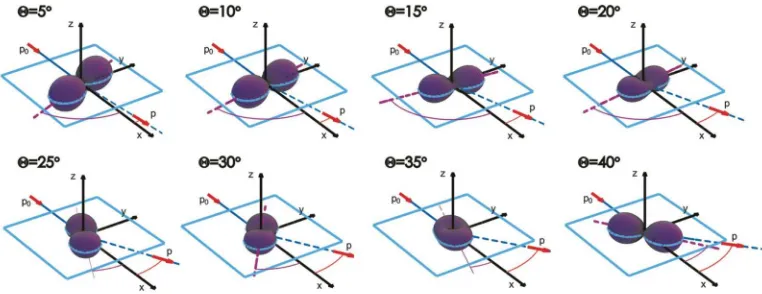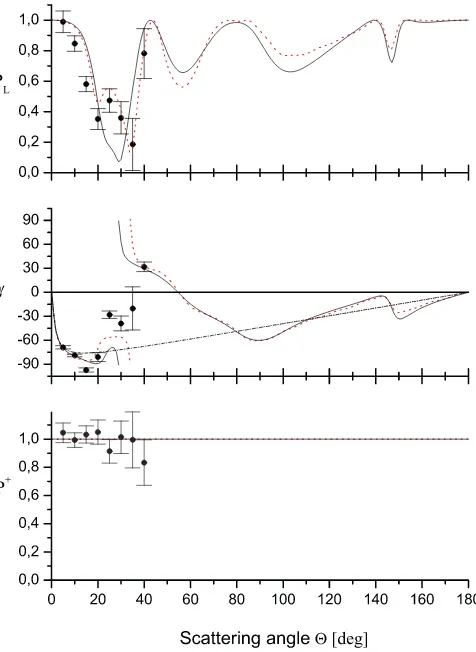Electron excitation of the 4
1P
1state of a zinc atom
Mariusz Piwi´nski,*Łukasz Kłosowski, Dariusz Dziczek, and Stanisław Chwirot
Nicolaus Copernicus University, Institute of Physics, Grudzia˛dzka 5/7, 87-100 Toru´n, Poland
Tapasi Das and Rajesh Srivastava
Department of Physics, Indian Institute of Technology, Roorkee 247 667 Uttranchal, India
A. D. Stauffer
Department of Physics and Astronomy, York University, Toronto, Ontario, Canada M3J 1P3
Christopher J. Bostock, Dmitry V. Fursa, and Igor Bray
ARC Centre for Antimatter-Matter Studies, Curtin University, GPO Box U1987, Perth, Western Australia 6845, Australia
(Received 27 September 2012; published 19 November 2012)
Experimental results of Stokes parameters and electron-impact coherence parameters for excitation of 41P1 state of zinc atoms are presented. The electron-photon coincidence method in the coherence-analysis version was applied to obtain data for scattering angles in the range from 5◦ to 40◦ for incident electron energy 100 eV. The experimental results are presented together with convergent-close-coupling-method and relativistic-distorted-wave-approximation theoretical predictions.
DOI:10.1103/PhysRevA.86.052706 PACS number(s): 34.80.Dp, 34.80.Pa
I. INTRODUCTION
Alkaline-earth metals and other atoms with two valence electrons outside a relatively inert core such as Zn, Ca, Cd, and Hg are very interesting objects for theoretical and experimental investigations of electronic collisions.
The most detailed information about inelastic-scattering processes can be obtained in electron-photon coincidence measurements [e.g., Stokes parameters or electron-impact coherence parameters (EICPs)]. Due to the complexity and long time required for such experiments, the amount of available data on such collision systems is rather limited [1–11]. Therefore, more experimental results are still needed to test and develop the theoretical models.
The present work is a continuation of our previous coincidence studies of electron scattering on Ca and Cd atoms [12–14]. The next target—zinc—has been investigated in experimental and theoretical studies of interactions with polarized electrons. Very interesting information on spin-dependent effects in formation of negative ions has been summarized in Ref. [15]. Some unexpected effects have been also revealed in3S
1state excitation by polarized electrons [16],
providing additional justification for coincidence experiments on Zn. The first set of coherence parameters for Zn atoms excited to the 41P
1state by electrons with incident energy of
100 eV is presented in this paper. The theoretical relativistic-distorted-wave approximation (RDWA) and convergent-close-coupling (CCC) predictions for the full range of scattering angles are also shown.
II. APPARATUS
The experimental setup used in the present work was essentially the same as the one used in experiments on
electron-impact excitation of cadmium atoms [14,17]. A diagram of the apparatus is shown in Fig.1. The geometry of the experiment was typical for the coherence-analysis version of electron-photon coincidence measurements.
The electron-atom collisions took place in a vacuum chamber with typical pressure of 5×10−7mbar with the Zn
atomic beam effusing from a magnetically shielded oven. The electron and atomic beams were cross-fired, creating an interaction region of a diameter 1.5–2 mm located 22 mm above the two-stage collimator of the atom source. The typical operating temperatures of the oven were 341◦
C for the main reservoir and 355◦
C for the nozzle. Number density of the Zn atoms was of the order of 1010 atoms/cm3 in the interaction
region. The electron beam of energy 100 eV and 3–6μA of current was produced by a Comstock EG-402EL electron gun. A Comstock AC-901 electrostatic electron-energy analyzer was used for energy selection of the electrons scattered by atoms and observed at the fixed scattering angle . During coincidence measurements the analyzer transmitted electrons which had lost the energy corresponding to the excitation of Zn atoms from their ground to the 41P
1 state.
The combined energy resolution of the electron gun and the energy analyzer was about 0.7 eV. The acceptance angle of the electron detection channel was 0.06 rad. A typical energy-loss spectrum is shown in Fig.2.
Photons of the wavelength 213.8 nm emitted spontaneously by atoms relaxing from the 41P
1 to their ground state were
detected in the direction perpendicular to the scattering plane defined by the momenta of the impacting and the observed scattered electrons. The polarization state of the emitted radiation was determined with a custom-made pile-of-plates polarizer and a zero-order quartz retardation plate (Melles Griot). The acceptance angle of the photon detection channel was approximately 0.2 rad.
FIG. 1. Diagram of the apparatus for electron-photon coincidence investigations in the coherence-analysis version. EG: electron gun (Comstock EG-402EL); EEA: electron-energy analyzer (AC–901, Comstock); CH: channeltron (7010M, Photonis); OV: the source of the atomic beam (stainless-steel oven with two-stage collimator); QL: quartz lens; λ/4: zero-order quartz retardation plate (Melles Griot); POP: “pile-of-plates” polarizer (eight quartz plates); F: broadband filter (213.8 nm, Roper Scientific); PMT: photomultiplier (9235QSB, THORN EMI); CFD: constant-fraction discriminator; SMC: stepper-motor controller; TAC: time-to-amplitude converter; AMP: preamplifier; DLY: delay line; MCA: multichannel analyzer.
III. EXPERIMENTAL PROCEDURES
The main procedure involved accumulating the electron-photon coincidence spectra, as well as counting the 213.8-nm photons and electrons scattered at the selected angle with the apt energy loss. The signals required to determine a single polarization data point were acquired by repeating a cycle of two 300-s integration steps at different positions of the polar-izer. Such a procedure allowed us to minimize the effects of long-term drifts of the experimental conditions. The number of the true coincidence counts accumulated at each position was scaled with the corresponding number of detected electrons. Photon count rates were used to monitor the noncoincidence Stokes parameters. Low-level fluctuations around their known (previously measured) values provided verification of good
FIG. 2. Energy-loss spectrum of scattered electrons observed at 10◦
scattering angle for incident electrons of energy 100 eV.
FIG. 3. Typical electron-photon coincidence spectrum accumu-lated for electron scattering angleof 10◦.
overall stability of the experimental conditions. Time required for determination of each of the Stokes parameters varied from four days to two weeks depending on the scattering angle. Measurements of individual ones (P1,P2, andP3) were carried
out in separate runs. Accumulated coincidence spectra were used to determine the Stokes parameters [18]:
P1 =
N0−N90 N0+N90 ,
P2 =
N45−N−45 N45+N−45
, (1)
P3 =
N45C−N−45C N45C+N−45C ,
whereN0,N90,N−45, andN45are numbers of true coincidence
counts collected at four respective settings of the transmission axis of the linear polarizer.N45CandN−45C stand for the true
coincidence counts collected at the two relative positions of linear polarizer and theλ/4 plate. The raw values of the Stokes parameters were corrected for the finite polarizability of the polarization analyzer (81% at 213.8 nm) and used to calculate the EICPs [19] characterizing the shape
PL=
P2
1 +P
2
2 (2)
and the alignment of the electron charge cloud after the excitation
γ = 1
2arg(P1+iP2), (3)
as well as the angular momentum transfer during the collision
L⊥= −P3 (4)
and the degree of the coherence of the excitation process
P+=
P12+P22+P32. (5)
IV. RDWA CALCULATIONS
TABLE I. Stokes parameters and EICPs for excitation of Zn atoms to the 41P1state by 100 eV electrons. Listed experimental uncertainties are single standard deviations.
(deg) P1 P2 P3= −L⊥ PL γ (deg) P+
5 −0.73±0.07 −0.67±0.08 −0.34±0.06 0.99±0.08 −69±3 1.04±0.07
10 −0.79±0.06 −0.31±0.05 −0.52±0.06 0.85±0.06 −79±2 0.99±0.06
15 −0.56±0.05 0.15±0.06 −0.85±0.07 0.58±0.05 −97±3 1.03±0.07
15 0.11±0.09 Repeated measurement
20 −0.33±0.07 −0.11±0.07 −0.99±0.09 0.35±0.07 −81±6 1.05±0.09
25 0.26±0.08 −0.39±0.08 −0.78±0.09 0.47±0.08 −28±5 0.91±0.09
25 0.22±0.14 Repeated measurement
30 0.07±0.12 −0.35±0.11 −0.95±0.12 0.36±0.11 −39±10 1.01±0.12
35 0.14±0.17 −0.12±0.19 −0.98±0.20 0.19±0.18 −20±27 0.99±0.20
40 0.34±0.17 0.70±0.17 −0.29±0.14 0.78±0.17 32±6 0.83±0.17
scattering. This method is particularly suited for calculations of heavier atoms or when the incident electrons are spin polarized. Both the atomic wave functions and those for the scattered electron are solutions of the relativistic Dirac equations. Details of the scattering calculation have been described by Chauhanet al.[20].
Recently, Daset al.[21] have published cross sections for the excitation of Zn atoms using elaborate multiconfiguration Dirac-Fock wave functions calculated using the GRASP2K
program [22]. Details of the configurations used and the results for the atomic properties are given in the former paper. We used those wave functions to calculate the scattering amplitudes and then the differential Stokes parameters (reported here) according to the formulas given in Ref. [23].
As a perturbative method, the RDWA is reliable at medium and high energies. At the energy used in the measurements reported here (100 eV), the method is expected to give good results for all scattering angles. Comparisons with the experimental results and CCC calculations are given in Sec.VI.
V. CCC METHOD
The Stokes parameters and EICPs were extracted from the calculation performed in the CCC(206) model that was detailed in Ref. [24]. Briefly, the CCC method models the Zn atom as a quasi-two-electron system that has two active
electrons above an inert Hartree-Fock core. The set of Zn target states was obtained by performing two-electron configuration-interaction (CI) calculations. One-electron orbitals required for CI calculations were obtained via diagonalization of the Zn+
quasi-one-electron Hamiltonian in the (Laguerre) Sturmian basis. Orbitals with orbital angular momentum l=0, 1, 2, and 3 were included in the calculations. In order to improve the accuracy of target wave functions and approximately model core-valence electron correlations we included one-and two-electron polarization potentials.
The size of the CI expansion depends significantly on the number of one-electron orbitals and choice of configurations. In the CCC(206) model we used nine, eight, eight, and five low-lying Zn+
orbitals for l=0, 1, 2, and 3, respectively. The set of configurations was defined by allowing one of the active electrons to occupy 4s or 4d orbitals only while the other electron was allowed to occupy any other orbital. This led to the total of 206 states of singlet and triplet spin and orbital angular momentum ranging from zero to 4. The use of a Sturmian basis in CCC calculations is important as it allows us to model the whole spectrum of the target atom. The low-lying negative-energy states (relative to the Zn+
ground state) provide a sufficiently accurate description of the Zn-atom bound states, while the positive-energy pseudostates provide a square-integrable discretization of the Zn-atom continuum.
FIG. 4. (Color online) Graphical representations of angular distributions of the electron charge cloud of the excited 41P1state of Zn for experimentally obtained values of the EICPs for different scattering angles (from 5◦
The set of Zn target states was used to perform a multichan-nel expansion of the total wave function of thee-Zn scattering system and set up a system of coupled Lippmann-Schwinger equations for theTmatrix. Upon solution we formed scattering amplitudes for the transition of interest. Differential and integral cross sections and Stokes parameters could then be evaluated in a standard way.
Relativistic effects proved to be of little importance for 41P state electron-photon coincidence studies presented in this paper. We have verified this explicitly by performing calculations using the fully relativistic CCC method [25,26]. The obtained results were practically the same as for nonrela-tivistic calculations. We note, however, that Zn is a sufficiently heavy target and depending on the transition and observable of interest the relativistic effects can be important; see, for example, measurements [27] and calculations [28] of the Sherman function fore-Zn elastic scattering.
VI. RESULTS AND DISCUSSION
The measurements were carried out for the electron energy of 100 eV and scattering angles in the range from 5◦
to 40◦
. The obtained values of the Stokes parameters and EICPs are presented in TableI.
FIG. 5. (Color online) Stokes parameters (P1,P2, andP3) for Zn 41P1state excitation by 100 eV electrons (•experiment; — RDWA theoretical predictions;· · ·CCC theoretical predictions). The mea-surements ofP1at scattering angle 25◦andP2at 15◦were repeated ().
EICP values for each scattering angle were used to plot three-dimensional representations [29] of the angular distributions of the density of the electron charge cloud of theP state (Fig.4).
The experimental values of Stokes parameters and EICPs are plotted together with the results of RDWA and CCC theoretical predictions (Figs.5and6).
Both the RDWA and CCC calculations are generally in a good qualitative agreement with the experimental data. Most of the characteristic features of the dependences of the parameters on the scattering angle are predicted, although some discrepancies should be noted.
In the case of the Stokes parameter P1 the experimental
result at scattering angle 25◦
is positive, while the values predicted by both CCC and RDWA theories are negative. Similar deviation exists for theP2Stokes parameter at 15◦. The PLparameter values calculated according to Eq.(2)yielded by
the CCC method are in very good agreement with experimental results, while the RDWA calculations provide slightly different values.
Independent measurements were carried out to verify these experimental points. The new values forP1 andP2 (0.22±
0.14 and 0.11±0.09, respectively) confirmed the earlier data (Fig.5, TableI).
From the experimental point of view the range of scattering angles from 15◦ to 30◦ is most convenient for conducting measurements. In such conditions the scattering plane is well defined, the scattered electrons are well energy selected, and the technical problems typical for low scattering angles are much less severe. Furthermore, the intensities of the detected signals are high and the measurements have good signal-to-noise ratio. All these factors allowed us to obtain experimental results with relatively small error bars.
In the case of P3 parameter values both RDWA and
CCC calculations yielded similar results. In the range of low scattering angles the curves are slightly above the experimental values. The deviations between theoretical predictions and measured values are less significant for higher scattering angles.
The experimentally obtained results for the coherence parameter P+
agree (within the limits of uncertainty) with the value of 1 expected for a fully coherent scattering process. Typical sources of systematic experimental errors, such as radiation trapping, would cause a partial depolarization of the detected fluorescence. Finite volume of the interaction region and effects of finite acceptance angles could also be sources of systematical errors in such measurements. Since the measured
total polarizationP+=
1 one can reasonably assume that none of those factors is responsible for the differences between the theoretical and experimental data.
The presented data for Zn confirm differences in the dependencies of Stokes parameters and EICPs on the scattering angle from those for Cd [17,30]. Dissimilarities are expected based on different spin-orbit-coupling schemes in the atoms. They pronounce themselves most clearly in the dependencies of PL on scattering angles and are reflected in the shapes of the electron-charge-cloud distributions of both targets.
VII. CONCLUSIONS
The experimental results for the Stokes parameters and EICPs for excitation of the 41P
1 state of zinc atoms were
presented together with CCC and RDWA theoretical predic-tions. Most of the characteristic features of the dependences of the parameters on the scattering angle are correctly predicted; nevertheless, there are some discrepancies between measurements and theoretical values. New experimental data for lower energies and a wider range of scattering angles are required to decide on needed improvements of the theoretical methods.
[1] M. E. Fayoumi, H. J. Beyer, F. Shahin, Y. Eid, and H. Kleinpoppen, in Proceedings of the 11th International Conference on Atomic Physics, edited by S. Haroche, J. C. Gay, and G. Grynberg (World Scientific, Singapore, 1989), pp. XI–2. [2] E. Zohny, M. E. Fayoumi, H. Hamdy, H. Beyer, Y. A. Eid, F. Shahin, and H. Kleinpoppen, in Proceedings of the 16th International Conference on Physics of Electronic and Atomic Collisions, edited by A. Dalgarno, R. S. Freund, M. S. Lubell, and T. B. Lucatorto (AIP, New York, 1989), p. 173.
[3] A. A. Zaidi, I. McGregor, and H. Kleinpoppen,Phys. Rev. Lett.
45, 1168 (1980).
[4] A. Zaidi, S. Khalid, I. McGregor, and H. Kleinpoppen,J. Phys. B14, L503 (1981).
[5] G. F. Hanne, K. Wemhoff, A. Wolcke, and J. Kessler,J. Phys. B
14, L507 (1981).
[6] A. Wolcke, J. Goeke, G. F. Hanne, J. Kessler, W. Vollmer, K. Bartschat, and K. Blum,Phys. Rev. Lett.52, 1108 (1984).
[7] J. Goeke, G. F. Hanne, and J. Kessler,Phys. Rev. Lett.61, 58
[11] C. Herting, S. Feldmann, S. Geers, and G. F. Hanne, in
Correlations, Polarization, and Ionization in Atomic Systems, edited by D. H. Madison and M. Schulz, AIP Conf. Proc. No. 604 (AIP, New York, 2002), p. 238.
[12] S. Chwirot, D. Dziczek, R. Srivastava, D. Dyl, and R. Dygdała,
J. Phys. B29, 5919 (1996).
[13] D. Dyl, D. Dziczek, M. Piwi´nski, M. Gr ˛adziel, R. Srivastava, R. Dygdała, and S. Chwirot,J. Phys. B32, 837 (1999).
[14] M. Piwi´nski, D. Dziczek, R. Srivastava, M. Gr ˛adziel, and S. Chwirot,J. Phys. B35, 3821 (2002).
[15] J. F. Williams, L. Pravica, D. Cvejanovic, S. N. S. Samarin, and M. Piwinski,J. Phys.: Conf. Ser.235, 012005 (2010).
[16] L. Pravica, J. F. Williams, D. Cvejanovi´c, S. Samarin, K. Bartschat, O. Zatsarinny, A. D. Stauffer, and R. Srivastava,
Phys. Rev. A83, 040701 (2011).
[17] M. Piwi´nski, D. Dziczek, Ł. Kłosowski, R. Srivastava, and S. Chwirot,J. Phys. B39, 1945 (2006).
[18] M. Born and E. Wolf,Principles of Optics, 7th ed. (Cambridge University Press, Cambridge, UK, 1999).
[19] N. Andersen, J. W. Gallagher, and I. V. Hertel,Phys. Rep.165, 1 (1988).
[20] R. K. Chauhan, R. Srivastava, and A. D. Stauffer,J. Phys. B38,
2385 (2005).
[21] T. Das, L. Sharma, R. Srivastava, and A. D. Stauffer,Phys. Rev. A86, 022710 (2012).
[22] P. J¨onsson, X. He, C. F. Fischer, and I. P. Grant,Comput. Phys. Commun.117, 597 (2007).
[23] K. Bartschat, K. Blum, G. F. Hanne, and J. Kessler,J. Phys. B
14, 3761 (1981).
[24] S. A. Napier, D. Cvejanovi´c, J. F. Williams, L. Pravica, D. Fursa, I. Bray, O. Zatsarinny, and K. Bartschat,Phys. Rev. A79, 042702 (2009).
[25] D. V. Fursa and I. Bray,Phys. Rev. Lett.100, 113201 (2008).
[26] C. J. Bostock, D. V. Fursa, and I. Bray,Phys. Rev. A82, 022713 (2010).
[27] M. Bartsch, H. Geesmann, G. F. Hanne, and J. Kessler,J. Phys. B25, 1511 (1992).
[28] C. J. Bostock, D. V. Fursa, and I. Bray,Phys. Rev. A85, 062707
(2012).
[29] N. Andersen and K. Bartschat, Polarization, Alignment, and Orientation in Atomic Collisions (AIP Press, Springer, New York, 2001).


